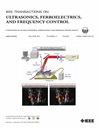Active Inference and Deep Generative Modeling for Cognitive Ultrasound
IF 3
2区 工程技术
Q1 ACOUSTICS
IEEE transactions on ultrasonics, ferroelectrics, and frequency control
Pub Date : 2024-09-23
DOI:10.1109/TUFFC.2024.3466290
引用次数: 0
Abstract
Ultrasound (US) has the unique potential to offer access to medical imaging to anyone, everywhere. Devices have become ultraportable and cost-effective, akin to the stethoscope. Nevertheless, and despite many advances, US image quality and diagnostic efficacy are still highly operator- and patient-dependent. In difficult-to-image patients, image quality is often insufficient for reliable diagnosis. In this article, we put forth the idea that US imaging systems can be recast as information-seeking agents that engage in reciprocal interactions with their anatomical environment. Such agents autonomously adapt their transmit-receive sequences to fully personalize imaging and actively maximize information gain in situ. To that end, we will show that the sequence of pulse-echo experiments that a US system performs can be interpreted as a perception-action loop: the action is the data acquisition, probing tissue with acoustic waves and recording reflections at the detection array, and perception is the inference of the anatomical and or functional state, potentially including associated diagnostic quantities. We then equip systems with a mechanism to actively reduce uncertainty and maximize diagnostic value across a sequence of experiments, treating action and perception jointly using Bayesian inference given generative models of the environment and action-conditional pulse-echo observations. Since the representation capacity of the generative models dictates both the quality of inferred anatomical states and the effectiveness of inferred sequences of future imaging actions, we will be greatly leveraging the enormous advances in deep generative modeling (generative AI), which are currently disrupting many fields and society at large. Finally, we show some examples of cognitive, closed-loop, US systems that perform active beamsteering and adaptive scanline selection based on deep generative models that track anatomical belief states.用于认知超声的主动推理和深度生成模型。
超声波具有独特的潜力,可为任何人、任何地方提供医学成像服务。设备已变得超便携、经济实惠,就像听诊器一样。然而,尽管取得了许多进步,超声图像的质量和诊断效果仍然在很大程度上取决于操作者和患者。对于难以成像的病人,图像质量往往不足以进行可靠的诊断。在本文中,我们提出了一个观点,即超声成像系统可以被重塑为与解剖环境进行互惠互动的信息探针。这种代理可自主调整其发射-接收序列,以实现完全个性化的成像,并积极最大限度地获取现场信息。为此,我们将展示超声系统执行的脉冲回波实验序列可被解释为感知-动作循环:动作是数据采集,用声波探测组织并记录检测阵列的反射;感知是对解剖和功能状态的推断,可能包括相关的诊断量。然后,我们为系统配备了一种机制,可在一系列实验中主动减少不确定性并最大限度地提高诊断价值,在给定环境生成模型和动作条件脉冲回波观测结果的情况下,利用贝叶斯推理联合处理动作和感知。由于生成模型的表示能力决定了推断解剖状态的质量和推断未来成像动作序列的有效性,我们将极大地利用深度生成建模(生成式人工智能)的巨大进步,这些进步目前正在颠覆许多领域和整个社会。最后,我们将展示一些认知闭环超声系统的实例,这些系统可根据跟踪解剖学信念状态的深度生成模型,执行主动波束转向和自适应扫描线选择。
本文章由计算机程序翻译,如有差异,请以英文原文为准。
求助全文
约1分钟内获得全文
求助全文
来源期刊
CiteScore
7.70
自引率
16.70%
发文量
583
审稿时长
4.5 months
期刊介绍:
IEEE Transactions on Ultrasonics, Ferroelectrics and Frequency Control includes the theory, technology, materials, and applications relating to: (1) the generation, transmission, and detection of ultrasonic waves and related phenomena; (2) medical ultrasound, including hyperthermia, bioeffects, tissue characterization and imaging; (3) ferroelectric, piezoelectric, and piezomagnetic materials, including crystals, polycrystalline solids, films, polymers, and composites; (4) frequency control, timing and time distribution, including crystal oscillators and other means of classical frequency control, and atomic, molecular and laser frequency control standards. Areas of interest range from fundamental studies to the design and/or applications of devices and systems.

 求助内容:
求助内容: 应助结果提醒方式:
应助结果提醒方式:


